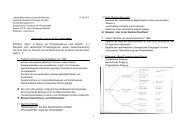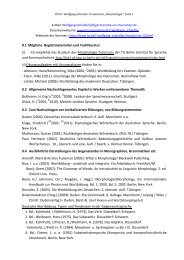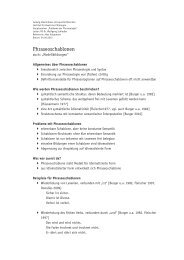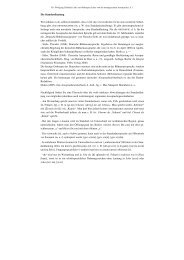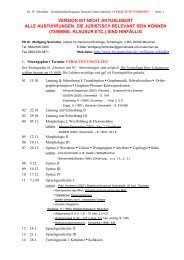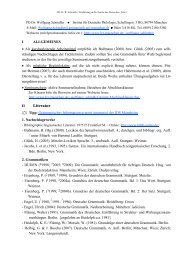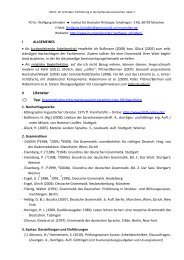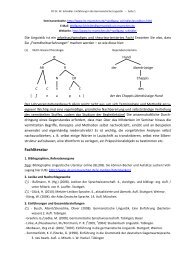Chapter 18 Lexical Functions: Description of Lexical Relations in a ...
Chapter 18 Lexical Functions: Description of Lexical Relations in a ...
Chapter 18 Lexical Functions: Description of Lexical Relations in a ...
Create successful ePaper yourself
Turn your PDF publications into a flip-book with our unique Google optimized e-Paper software.
—<strong>Chapter</strong> <strong>18</strong>. <strong>Lexical</strong> <strong>Functions</strong>— 54<br />
43. Oper i [Lat. operāri (do, carry out)] = support verb with L as 1st Object<br />
The DSyntA I <strong>of</strong> an Oper i verb = L ´(and its SSynt-Subject) is the phrase that is described<br />
<strong>in</strong> the Government Pattern <strong>of</strong> L as the i-th DSyntA(L), and Oper i’s DSyntA II (= its ma<strong>in</strong> S(urf-<br />
ace)Synt-Object is L itself. 15 Further DSyntAs <strong>of</strong> an Oper i , if any, are the phrases described <strong>in</strong><br />
the GP <strong>of</strong> L as further DSyntAs <strong>of</strong> L.<br />
Examples<br />
Oper 1(blowN) = deal, strike [NY ART ~] Oper 2(blowN) = receive, take [ART ~ from NX]<br />
Oper 1(supportN) = give, lend, <strong>of</strong>fer [~ to NY] Oper 2(supportN) = receive [~ from NX]<br />
Oper 1 (orderN) = give [ART ~ to NZ] Oper 3 (orderN) = receive [ART ~ from NX]<br />
Oper 1(resistance) = put up [ART ~], Oper 2 (resistance) = meet [ART ~], run [<strong>in</strong>to ART ~]<br />
<strong>of</strong>fer [ART/Ø ~]<br />
Oper 1(controlN) = have [~ over NY] Oper 2 (controlN) = be [under NX’s ~]<br />
Oper 1 (examN) = give [ART ~] Oper 2(examN) = take [ART ~] Oper 3(examN) = be [on ART ~]<br />
The expression <strong>in</strong> brackets follow<strong>in</strong>g each element <strong>of</strong> the value <strong>of</strong> the LF illustrated is <strong>in</strong><br />
po<strong>in</strong>t <strong>of</strong> fact its reduced Government Pattern—its lexical subentry; for a discussion <strong>of</strong><br />
such subentries, see 5.1, p. 00.<br />
In case an Oper i verb admits only a dummy subject (a purely grammatical lexeme,<br />
which has no mean<strong>in</strong>g <strong>of</strong> its own), the subscript ‘ 0’ is used: Rus. Oper 0(zapax (smell)) = tjanut´<br />
[~om] [Iz podvala tjanulo zapaxom moči lit. (From the-basement [it] pulled with-the-smell <strong>of</strong>-<br />
ur<strong>in</strong>e), with a zero dummy subject Ø3sg.neu], Fr. Oper 0(baisse (decrease)) = on constate une baisse<br />
lit. (One sees a decrease) [with the subject ON], Ger. Oper 0(Problem (problem)) = Es gibt e<strong>in</strong><br />
grosses Problem lit. (It gives [a big problem]) [with the subject ES].<br />
Let it be recalled (p. 00, NB under Conv, No. 3) that all Oper is are counted as one LF, and<br />
so are all Func is and all Labor ijs, see below.<br />
44. Func i [Lat. *functionāre ([to] function) = support verb with L as Surface Subject<br />
The DSyntA I <strong>of</strong> the Func i verb (and its SSynt-Subject) is L itself, and its DSynt-actant II<br />
(= its ma<strong>in</strong> SSynt-Object) is the i-th DSyntA(L).<br />
Examples<br />
Func 1(blowN) = comes [from NX] Func 2(blowN) = descends [on NY], falls [upon NY]<br />
Func 1(proposal) = comes, stems [from NX] Func 2(proposal) = concerns [NY]


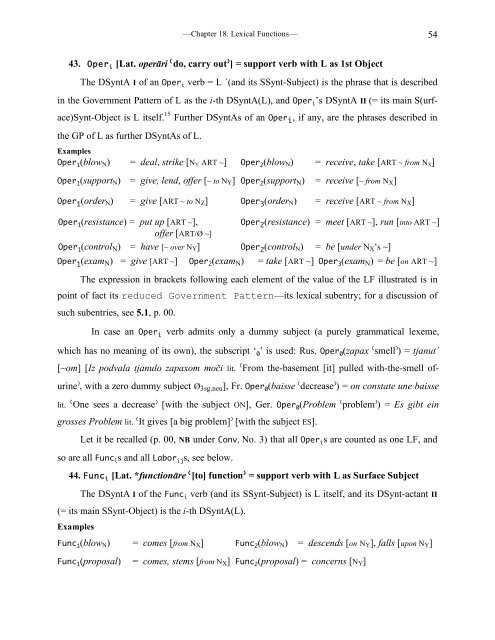
![E-Mail: Wolfgang.Schindler[ätt]germanistik.uni-muenchen.de Web ...](https://img.yumpu.com/51590147/1/184x260/e-mail-wolfgangschindlerattgermanistikuni-muenchende-web-.jpg?quality=85)
